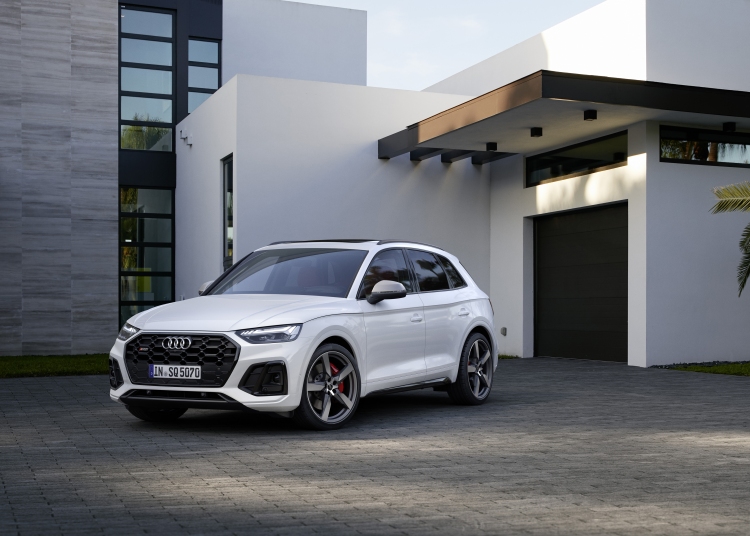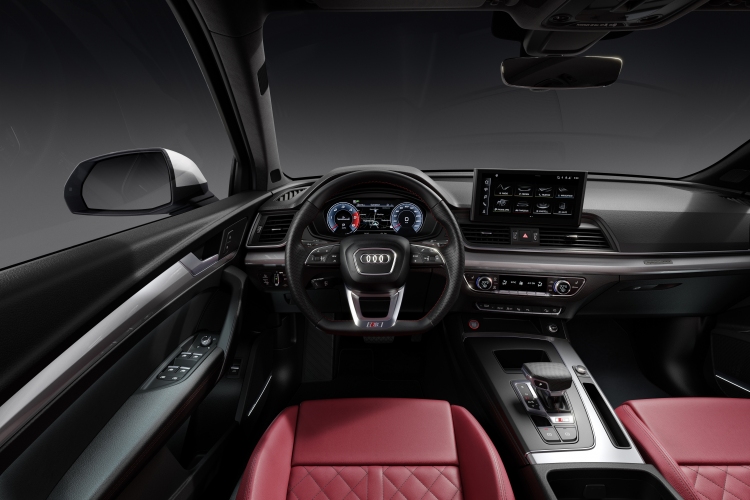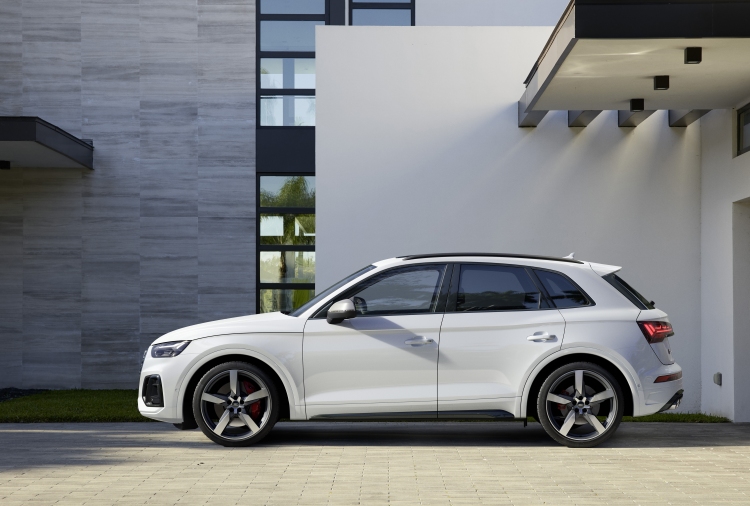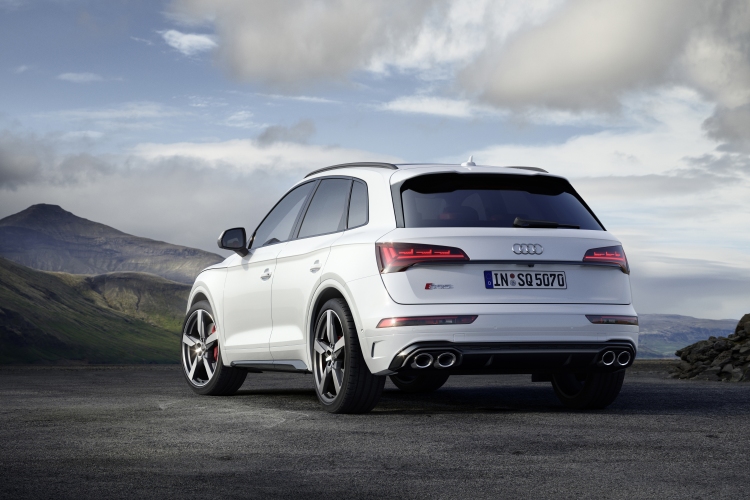The new Audi SQ5 TDI
Even sharper, sportier, and more efficient: The optimized Audi SQ5 TDI now looks even more impressive. Its V6 three-liter diesel engine with an output of 251 kW (341 PS) delivers its power smoothly and forcefully.
The sharper design underlines the sporty character of the sports SUV. Rear lights featuring the new digital OLED technology are available as an option for the top Q5 model.
The SQ5 TDI has a successful track record. Its first-generation, which was launched in the fall of 2012, already marked the starting point for a success story - as the first Audi S model powered by a diesel engine.
In its latest extended version, the three-liter V6 boasts an output of 251 kW (341 PS) and 700 Nm (516.3 lb-ft) of torque. The wide engine speed range can be used continuously between 1,750 rpm and 3,250 rpm. The 3.0 TDI develops its power earlier and more forcefully than before. It accelerates the top model of the Q5 product line from 0 to 100 km/h (0 to 62.1 mph) in 5.1 seconds and on to an electronically limited top speed of 250 km/h (155.3 mph). An actuator in the exhaust system, as fitted to the first SQ5 TDI, gives the V6 a sonorous sound.
Three-liter TDI with extensive innovations - now even more powerful and efficient
Many details of the V6 3.0 TDI have been revised. The pistons are no longer made of aluminum but of forged steel– the new material reduces heat losses. Due to the higher strength, they do not incur a weight penalty compared with the aluminum pistons. A stepped recess in the piston makes combustion faster and more efficient. The solenoid injectors used to inject the fuel operate with consistently high precision thanks to a new piezo sensor that monitors the closing of the needle. They can perform up to eight injections per work cycle, with injection quantities that are scalable with even greater precision. The maximum injection pressure is 2,500 bar.
The intercooler has been changed over from an air/air cooler in the bumper to an indirect water/air cooler in the inside V of the engine. The shortened intake air paths help to build up boost pressure quickly. The indirect intercooler is more effective and can even heat the intake air shortly after the engine is started in cold ambient conditions in order to reach the ideal combustion temperatures more quickly. This offers the advantage since exhaust gas cleaning responds more quickly
The turbocharger now features a smaller and lighter compressor wheel that gets into gear with exceptional speed - a key factor in the engine’s spontaneous and high torque build-up. The exhaust manifold benefits from improved insulation. Thanks to this measure, the exhaust gas reaches the optimum temperature more quickly after a cold start.
MHEV and EPC: even greater efficiency and spontaneity
The 3.0 TDI brings two technologies that reduce consumption and improve the engine response. The 48-volt mild hybrid system (MHEV) integrates a belt alternator starter (BAS), a lithium-ion battery that provides buffer storage, and a 48/12-volt voltage converter. When the car decelerates, the MHEV system recovers up to 8 kW of power. The sports SUV can coast for up to 40 seconds with the engine switched off - after which time the powerful BAS conveniently restarts the engine. The MHEV system has the potential to reduce customer fuel consumption by up to 0.7 liters (0.2 US gal) per 100 kilometers (62.1 mi).
The second technology component is the electrically powered compressor (EPC), which helps out whenever the exhaust gas flow provides too little energy to drive the turbocharger. A compact electric motor, which also uses the compact 48-volt system, accelerates the compressor wheel of the EPC to 65,000 rpm in roughly 300 milliseconds. The EPC is now used more frequently and across a broader engine map. It supports a more spontaneous engine response when the vehicle moves off as well as when accelerating from low engine speeds. The optimized interaction between the components EPC, MHEV, turbocharger, the engine itself, and the Tiptronic transmission support this effect.
Sport differential: more torque, no understeer, greater dynamism
On request, Audi can fit the sport differential on the rear axle, which actively controls the distribution of torque between the wheels when the driver adopts a sporty driving style. It sends more torque to the rear wheel on the outside of the curve that has a better grip - literally pressing the car into the curve and reducing understeer considerably. The rear wheel on the outside of the curve also receives more torque when the car is accelerating out of tight-radius curves to further improve driving dynamics.
New accents: the exterior design
The modified Audi SQ5 TDI has a powerful stance, with striking details that give it an even more rugged appearance. Vertical fins provide structure to the large side air inlets on the front bumpers. In the octagonal Singleframe grille that is specific to the S models, large octagonal honeycomb sections are linked by narrow bars. These have an aluminum finish, as do the fins on the air inlets.
Audi includes LED headlights as standard and offers Matrix LED headlights with automatic high beam and dynamic turn signals as an option. At the rear, a matte aluminum strip is integrated into the lower bumpers, below which are the diffuser insert and four chromium-plated oval tailpipe trims. Customers have a choice of nine exterior paint finishes. The black styling package, which adds sporty accents, is available on request.
Find more Cars
Lamborghini Huracán EVO
The new Lamborghini Huracán EVO is the next generation V10 super sports car...
The rebirth of the legendary Jaguar D-type
Jaguar Classic is re-starting the production of the iconic D-type race car ...
Koenigsegg Jesko
The Koenigsegg Jesko inherits the mantle left by the Agera RS as the leadin...
Coffee Run with Deadmau5 - Episode 15
The fifteenth episode of Deadmau5 and friends on a Coffee Run. This episode...
The new BMW M3 and M4
New editions of the pace-setting high-performance sports cars from BMW show...
The all new S63 AMG 4MATIC
The most powerful high-performance sedan in the luxury segment sets new sta...
























